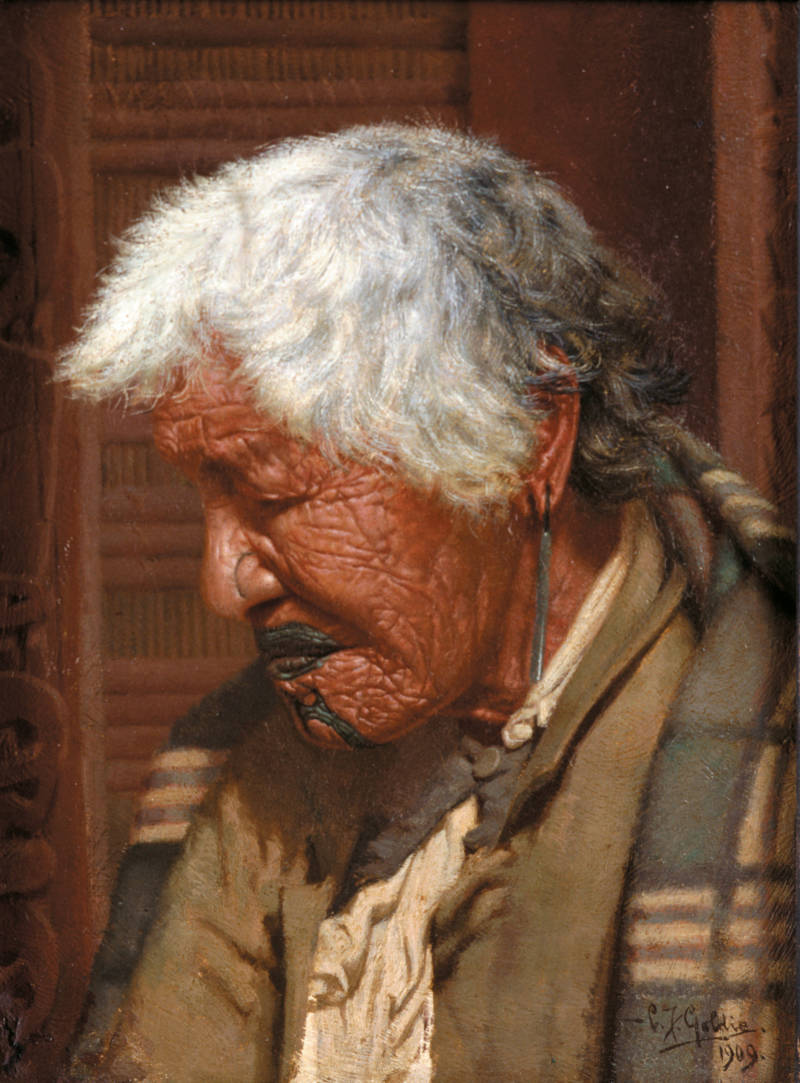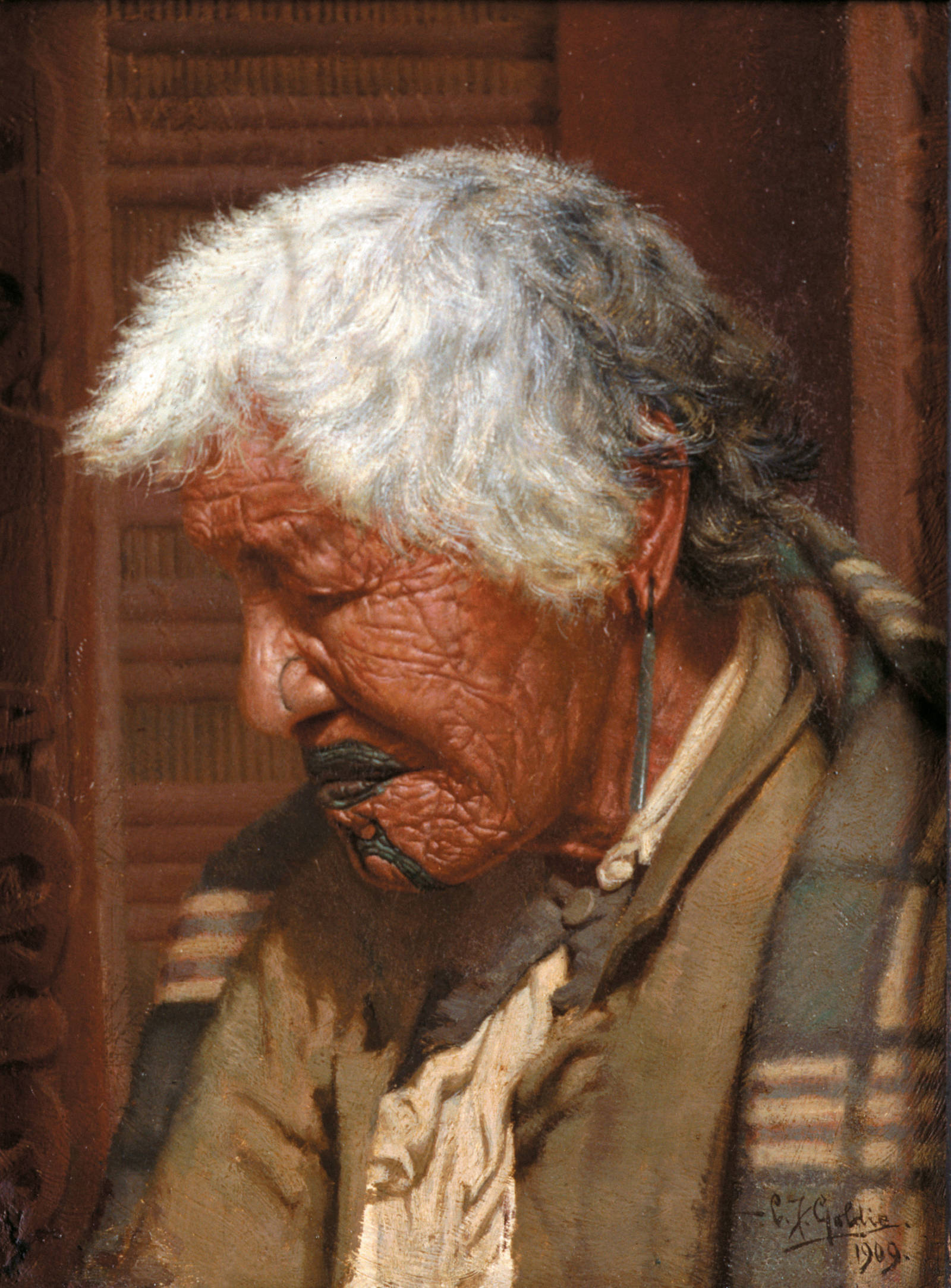GOLDIE, Charles Frederick;
Kapi Kapi or Ahinata Te Rangitautini
1909
Oil on board
190 x 140mm (image); 365 x 310mm (frame)

The following two texts were written for Te Huringa/Turning Points and reflect the curatorial approach taken for that exhibition.
Peter Shaw
Goldie is said in his late teens to have taken lessons in Auckland with Robert Atkinson, the painter of Portrait of Te Heuheu Tūkino IV, Horonuku and Portrait of Te Uira Te Heuheu. He trained in Paris at the Académie Julien and studied portraiture with Sir James Guthrie in London. Hence Goldie’s painterly ability to capture a precise likeness.
From 1901, Goldie made many trips to the Rotorua area, where he used to take photographs and make portraits. Ahinata Te Rangitautini of Whakarewarewa, known as Kapi Kapi, was a favourite subject, painted twenty-two times. Although this profile is one of the smallest, it lacks nothing in detail.
Kapi Kapi was a survivor of the 1886 Tarawera eruption, from which she was rescued by Sophia Hinerangi, the famous guide and another favourite Goldie subject. James Cowan wrote that her shoulders bore the scars of wounds inflicted with sharp obsidian as a sign of mourning and that Goldie had been interested to note that she was the only woman he had ever seen with a tattooed spiral on each nostril. Kapi Kapi was a venerable figure who died at the age of 102, apparently after falling into a hot pool—deliberately, it was said, as was the custom among Māori of the past.
Jo Diamond
He mihi aroha ki te tupuna whaea nei o te waka Te Arawa.
In reo Māori, I pay respect to this tupuna whaea (female ancestor) of the Tūhourangi, Te Arawa, and in doing so mirror the way many Māori people relate to Goldie’s portraits of our ancestors, considering the pictures to be their personifications. Māori audiences at the Goldie exhibitions that toured Aotearoa and Australia in the 1990s found a rare opportunity to ‘converse’ with their ancestors, acknowledging that their spirit remains in this painted form. While the artist may be criticised for his stereotyped records of a ‘dying race’, it is clear that we have nevertheless survived as a people and many of us are grateful to Goldie for keeping our ancestors’ memories alive.
We can marvel at the detail of this painting of a notable tupuna whaea. Her kauae chin moko and pounamu pendant ear ornament have been gracefully balanced with her deeply wrinkled face and grey-white hair, things that convey wisdom and experience more than declining old age. She reminds me of the lovely old nannies wrapped up in blankets and seen cracking jokes together on our marae. She is to be venerated at least for her survival through many years of human conflict and natural disaster. Her benign presence in this picture maintains her mana and inspires us onward toward our own challenges in life.
Goldie provides Māori people with an opportunity to reflect on the mana of women, despite dominant discourse in Māori culture that privileges men and excludes women. Such chauvinistic views continue to be held in both Māori and Pākehā social contexts and do little justice to the long lives of many of our tupuna whaea. In our national archives there are too many unidentified photographs of Māori women. Although it is unlikely that Goldie would have predicted such a feminist response to this work, I remain grateful to him all the same.
Exhibition History
Gathered Voices: Highlights from the Fletcher Trust Collection, New Zealand Portrait Gallery Te Pūkenga Whakaata, Te Whanganui-a-Tara, 15 September to 11 December 2022 (toured)
Te Huringa/Turning Points: Pākehā Colonisation and Māori Empowerment, Sarjeant Gallery Te Whare o Rehua, Whanganui, 8 April to 16 July 2006 (toured)
Auckland Society of Arts Exhibition, Tāmaki Makaurau, 1909
References
Evening Post, 24 October 1963.
New Zealand Herald, 25 October 1963.
Alister Taylor and Jan Glen (eds), C. F. Goldie, 1870–1947: His Life and Painting (Martinborough: A. Taylor, 1977), 208.
Provenance
1980s–
Fletcher Trust Collection
1963—?
Private collection, purchased for ₤700 from Dunbar Sloane, Te Whanganui-a-Tara, 24 October 1963
–1963
Unknown

